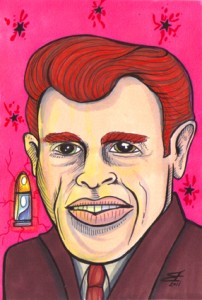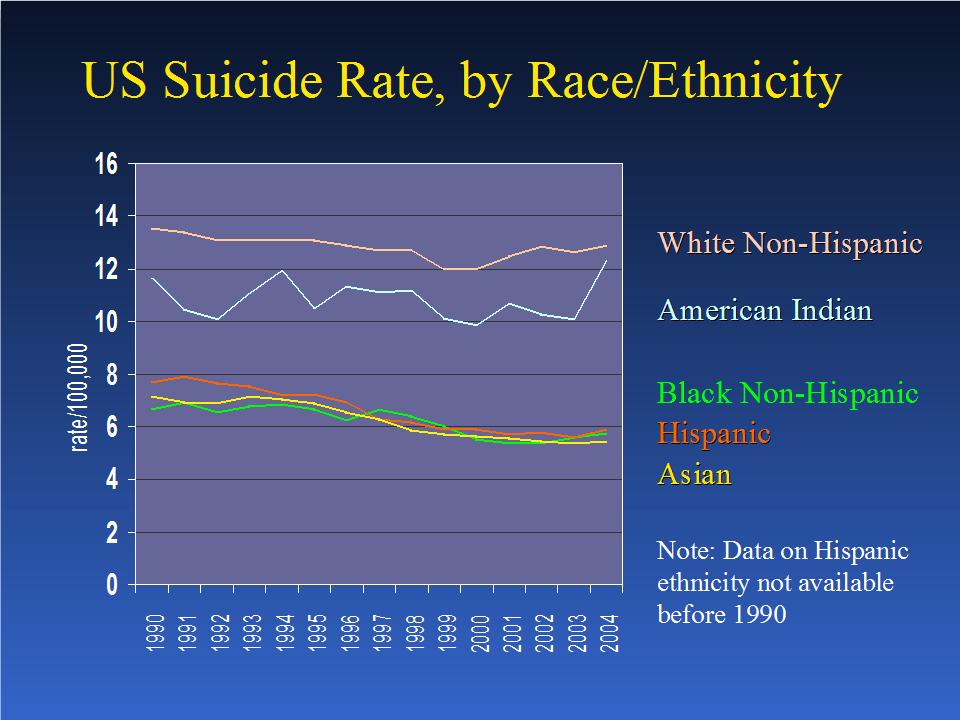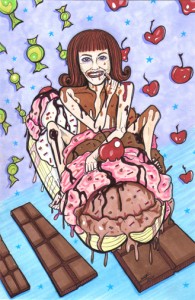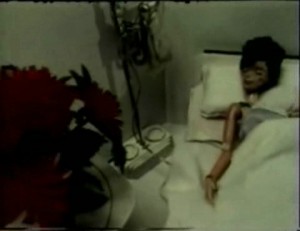On February 8, 1990, one-time teen idol Del Shannon sat down in his rocking chair, removed the toupée from his graying skullet, and shot himself with a .22 rifle. He was 55 years old. That most young readers won’t know Del Shannon’s name shows the difference between a rock star martyr and a troubling statistic. However, anyone who has listened to a Golden Oldies station should know his one and only #1 single, “Runaway.”
Shannon’s cartoonish falsetto and keyboardist Max Crook’s space age Musitron gripped the youth of that black-and-white era by their gonads and applied a jarring electrical current. At its peak in 1961, Del’s runaway hit (I had to say it) was moving more than 80,000 records per day. Considering the Dyonysian affection he received from groovy girls in the wake of “Runaway” (as seen below,) I hope Del went out with a satisfied smile on his face.
Statistically speaking, blowing your own brains out is a Caucasian activity. More specifically, it is the domain of middle aged-to-elderly white men.
The New York Times published “An Accounting of Daily Gun Deaths” five days after the 2007 Virginia Tech Massacre, putting the firearm-enabled tragedy into a national perspective. Citing 2004 CDC statistics, Bill Marsh uses colorful graphics to show what a typical day of American gun fatalities looks like. 29,569 people died from gunshots that year. Divided by 366 days, an average of 81 people died per day. Each color-coded bullet represents one gun-related death on a generic day:
 Pretty nifty, huh? The graph breaks these 81 deaths down by age, sex, and race (Hispanics are dispersed across white and black classifications.)
Pretty nifty, huh? The graph breaks these 81 deaths down by age, sex, and race (Hispanics are dispersed across white and black classifications.) 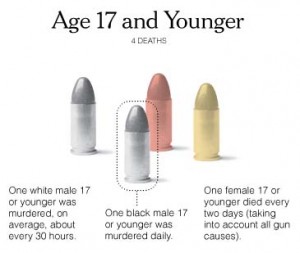 Assuming these trends have remained steady, four kids died today—two of which were murdered.
Assuming these trends have remained steady, four kids died today—two of which were murdered.
 The gangsta-leaning folly of youth violence just put six young black men in their graves, while groaning depression prompted four young white men to turn their guns on themselves.
The gangsta-leaning folly of youth violence just put six young black men in their graves, while groaning depression prompted four young white men to turn their guns on themselves.
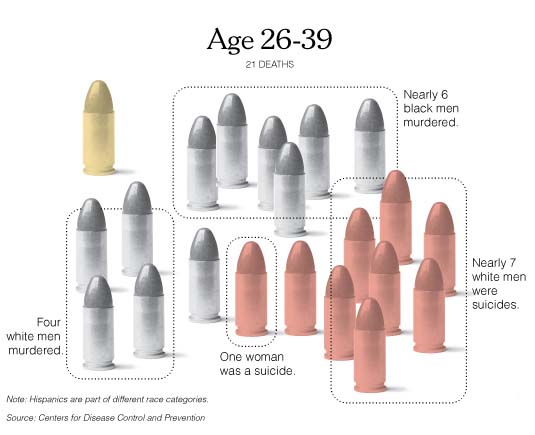 A black man is about as likely to get capped in full maturity as he was in his youth, while a white man becomes even more likely to shoot himself in his later years. By midnight, seven paleface gunslingers approaching mid-life will have called it quits in their prime. White men are also more likely to be murdered by guns later in life—perhaps because of their continuous belly-aching about the cruelty of a meaningless universe.
A black man is about as likely to get capped in full maturity as he was in his youth, while a white man becomes even more likely to shoot himself in his later years. By midnight, seven paleface gunslingers approaching mid-life will have called it quits in their prime. White men are also more likely to be murdered by guns later in life—perhaps because of their continuous belly-aching about the cruelty of a meaningless universe.
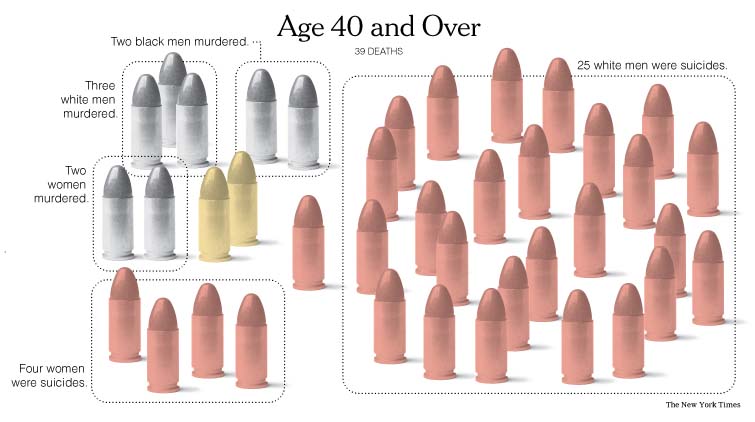 It comes as no surprise that if a black man has made it past 40, the last thing he’s gonna do is shoot himself. But today a whopping twenty-five middle aged-to-elderly white men cocked the hammer and followed the light to the end of the tunnel. We also see four sweet old white ladies tasting the blue steel, which doesn’t take into account those who emptied a bottle of pills or left the car running in the garage.
It comes as no surprise that if a black man has made it past 40, the last thing he’s gonna do is shoot himself. But today a whopping twenty-five middle aged-to-elderly white men cocked the hammer and followed the light to the end of the tunnel. We also see four sweet old white ladies tasting the blue steel, which doesn’t take into account those who emptied a bottle of pills or left the car running in the garage.
Suicide rates peaked in America during the 90s, when they began falling off in tandem with gun ownership until the around the year 2000. Perhaps malcontents were waiting to see if the unbearable world would just end. Well, it didn’t—and since 2000, suicides have increased steadily, at least among whites and Native Americans.
And I wonder…I wah wah wah wah wonder why so many aging white males choose to bite the flying bullet. I mean, we all know that getting old is tough but it beats the alternative. As my grandfather was fond of saying, “At my age, you realize you’ve overestimated the pleasure of a good lay, and underestimated the relief of a good crap.” Time ravaged his body as it will everyone’s, and yet ol’ Pap took it like a man, keeping faith that the immortal soul is greater than this sack of shit and bones.
The pain starts in joints and old injuries. Before you know it, you grunt with every motion. You find yourself reading the news compulsively, balking at taxes, grumbling about politics. And damnit to hell, these kids today! They call that music?! Of course, you’d diddle the cuties if you could, but you’re getting a bit long in the tooth for the young stuff. Probably couldn’t keep it up, anyway. Not with that swollen prostate pressing against your bladder. The mirror becomes your harshest critic. Your hairs are hapless natives—your scalp is Manifest Destiny. Those sexy suntans of years past have become deep lines and budding lumps of melanoma. Your torso is a ball of fur and sagging man-tits.
The best friends you ever had are either shells of their former selves or dead. The workday brings a barrage of insults and indignity. You’re just a number, and it ain’t Number One. Maybe that’s why your kids never call and your wife cuddles the dog more than you. Late at night, sodden with booze and regret, you caress old photos of the little runaway who wouldn’t stay. The memories are fading. The muscles atrophy. Death wafts from gaping pores into your veiny nose. Ascendant young lions are ready to take your wobbly knees out from under you at any moment. So you decide to beat ‘em to it. If you’re going to be a victim, why not be your own? Click…bang.
I feel your pain—you vainglorious, self-absorbed asshole. Sure, I’ll clean that up. No problem. Hope you feel better.
Del Shannon’s wife, Bonnie, found his body slumped in his bathrobe. It was the pathetic end to a life of constant sorrow. Del was big time #1—but only once. After the British Invasion swept him off the map in the mid-60s, he fell into a dark depression that dogged him to the bitter end. In 1964, he released his cover album Del Shannon Sings Hank Williams—one month before Hank’s sixth Death Day—which practically no one bought. He turned to the bottle for support, famously saying, “I hated the taste of booze, but I liked where it got me—into oblivion.”
Del made repeated attempts at a comeback, to no avail. You saw his face smiling, but his brow continued to frown. Still, he plugged away in earnest. His last performance was five days before he died, at Buddy Holly’s 31st [Death] Anniversary Concert and Dance. Maybe the morbid romance of that event rubbed off on him, or perhaps there is a pharmacological explanation. Two weeks before killing himself, Del began taking Prozac, which is now known to hurry chronic Eeyores along on their mopey race to the grave. And of course, Del’s .22 rifle was there to provide instant gratification.
Considering the fact that someone, somewhere, commits suicide every 40 seconds, why should anyone care about Del Shannon? Well, most people don’t. But there is at least one person who was absolutely devastated.
© 2011 Joseph Allen
